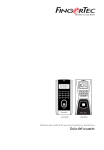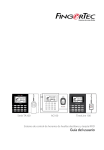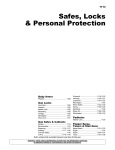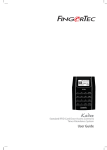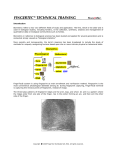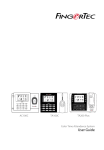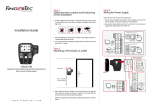Download i-Kiosk 100 user guide
Transcript
We Make Things Easy i-Kiosk 100 Premier Color Fingerprint Access Control & Time Attendance System User Guide CONTENTS 3-4 CHAPTER 1 • GETTING STARTED 21 Deleting Transaction Logs Deleting All Data Managing User Privilege Deleting Screen Savers Resetting to Factory Settings Viewing the User Manual in the Internet Included Accessories Included Printed Materials Activating Terminal Registering Terminal 22 5-7 CHAPTER 2 • BASICS Introduction to Terminal Terminal Overview Main Menu Power On/Off Button Date/Time Voice Control Security Features Cleaning Terminal Restarting and Resetting Terminal 8-11 CHAPTER 3 • USER Enrolling User Verifying User Adding User Information Deleting User Access Level/Privilege 12-16 CHAPTER 4 • CONNECTION – SYNCING Installations Communications Mount On Wall Descriptions of Available Connections Checking the genuine TCMS V2 Installation and Setup of TCMS V2 Connecting Terminal to TCMS V2 Using USB to download/upload data 17-20 CHAPTER 7 • USB Understanding the Need for USB Flash Disk Type of USB Downloading Data into USB Uploading Data from USB Uploading Pictures to the Terminal 23 CHAPTER 8 • KEYBOARD Shortcut Keys in Short Configuring Shortcut Keys 24 CHAPTER 9 • AUTO TEST Who should do the Auto Test? Audio Test Keybord Test Sensor Test RTC Test 25 CHAPTER 10 • BELL Definition of Schedule Bell Inserting Time to Trigger Schedule Bell Determining the Ring Type of Schedule Bell Adjusting Volume of the Bell Repetition State 26 CHAPTER 11 • ACCESS Using Terminal as Door Access How Long It Takes Before The Door Locks Again Delaying Door Sensor Choosing Door Sensor Type Delaying Alarm CHAPTER 5 • SYSTEM General Settings Display Settings Log Settings Update System Information CHAPTER 6 • DATA 27 CHAPTER 13 • TROUBLESHOOTING 29 OTHER RESOURCES Copyright Notice & Disclaimer 1 • GETTING STARTED Viewing the User Guide in the Internet The User Guide is available in the package when you purchase FingerTec terminal. The user guide is also published online at fingertec.com and user.fingertec.com. Choose the language you prefer to view the User Guide. Included Accessories Back Plate i-Kiosk 100 terminal A Packet of Bolts Star Screwdriver Door Accessories Cable Power Connector TCP/IP Connector Diod RFID Card (5 pieces) RS232/RS485 Wiegand Output Cable DC 12V Power Adapter Wiegand Input Cable Power Supply Cable CONTENTS 3 Included Printed Materials 5 RE SOFTWAGS SET TIN 4 RE SOFTWALATION V2 INSTAL r to TCMS 5 4 7 80 *Refe al Manu ESC 3 2 1 6 9 OK MENU r to *Refe V2 TCMS al Manu MS V2 TC TCMS ings TCMS ial Sett V2 Init allation V2 Inst 6 V2 Management TCMS Time Control nication Commu ings Sett e k Quic (Skip Guid Start gertec ser.fin http://u go to re info For mo ) ctionsfunctions e Fun dance endanctime atten e AttNOT using are For&Tim if you 8 9 8 7 *Refe al. V2 Manu TCMS ALL if using SET functions. both 9 rkin s of Wo up Gro Assign • • • • • To Wo Users up Gro lled uter insta comp V2 nal to termi with TCMS RE SOFTWA GS SET TIN r to steps rking g Tim System-V2 erprint d Finges Downloa Templat .com e & User Fill up tion Informa user inform ation in TCMS V2 Setting FingerTec Comprehensive DVD (with Product Code and Activation Key) Quick Start Guide Pamphlet User Enrollment Template Form Warranty Card Activating Terminal To activate the terminal, plug the DC 12V Power Adapter to the i-Kiosk 100, connect it to a standard power outlet and turn on the on/off button. To download the data from the i-Kiosk 100, you need to have the product key and activation code for the TCMS. The product key and activation codes can be retrieved at the back of the FingerTec Going Green CD case. In case you lose your TCMS V2 product key and activation code, go to user.fingertec.com/retrieve_key_user.php for retrieval. Registering Terminal Make sure that you register your i-Kiosk 100’s warranty with us at www.fingertec. com/ver2/english/e_main.html# 4 CONTENTS 2 • BASICS Introduction to Terminal We present you with the i-Kiosk 100 – FingerTec’s premium time attendance and door access terminal. The i-Kiosk 100 takes less than 2 seconds to verify your identity, with a choice of verifying by fingerprint, card, or password.The i-Kiosk 100 works perfectly as a standalone unit, and performs excellently in a networking environment. The USB function on the i-Kiosk 100 makes it even simpler to use, as updates, transaction logs and other information can be uploaded or downloaded into the terminal easily. As for security functions, the i-Kiosk 100 still has all the signature security features of FingerTec such as door access customization, external alarm option, and duress fingerprints. With additional features such as a full colour setting and picture screen savers, the i-Kiosk 100 is the advanced biometric device suitable for any workplace! Terminal Overview Color LCD Navigation Keys LED Function Keys USB PORT Keypads Speaker Card Induction Area Fingerprint Scanner Item Function LED Indicating status of terminal and result of verification Green – Terminal is in standby mode, or verify users successfully. Red – Terminal has failed to verify user. Function Keys Shortcut keys to enter specific command to terminal. Keypads To input instructions into the terminal and to allow configuration Card induction area Area that reads cards. Color LCD Screen that displays instruction and status of terminal. Fingerprint sensor To scan finger for confirmation of identity. Speaker For terminal voice emission. USB port To connect a USB extension for data download into a USB flash disk (pen drive). To connect a USB Keypad to input numerical commands into the terminal (optional). CONTENTS 5 Main Menu Enroll, edit, delete and insert user information from User icon. Setup FingerTec terminal communication with computer through LAN, RS232 and RS485. Set communication with a computer for a secure data transfer. Transfer data to and from the FingerTec the i-Kiosk 100 using a USB flash disk. Run tests on the i-Kiosk 100 to diagnose the terminal on various aspects. Configure the settings of the FingerTec terminals from general to display setting to fingerprint. Attendance settings and update settings are also done here. Check user attendance and transaction logs that are available in the i-Kiosk 100 and perform housekeeping of the machine. Adjust the date and time settings of the terminal Calibrate touch screen LCD panel of the i-Kiosk 100 for sustained performance. Power On/Off Button Use the power on/off button to turn the i-Kiosk 100 on or off. You can disable the button to avoid accidental shut off of the i-Kiosk 100. Refer to page 17, Chapter 5: System General Settings- Power Key for details. Mini UPS 12V can also be used to provide power supply to the i-Kiosk 100. Refer to accessory.fingertec.com for more information about accessories. Date/Time The i-Kiosk 100 displays the date and time at the home screen. Choose the date and time format based on your preference. Press Menu > Date/Time > Select value > Save. 6 CONTENTS Voice Control Voice Control lets you control the level of volume emitted by the i-Kiosk 100. Turn On/Off : The system lets you to turn on/off the voice based on your preference. Press Menu > System Icon > System > Voice Prompts > On/Off >Save. Adjust Volume: The default volume of the i-Kiosk 100’s voice is Medium. The volume has 3 settings: Low, Medium and High. To sustain the performance of the speaker, it is recommended to set the volume at Medium. To adjust the volume Press Menu > System Icon > System > Adj VOL (low/med/high) > Save. Security Features Security features help protect the information in the terminal from being accessed by others. Admin Affirm: Register an administrator to the system by enrolling a fingerprint or password to a user ID. Press Menu > User > New User > Auth: Administrator > Choose enrollment method > Save. After enrolling an administrator, the main menu can only be accessed by the administrator. Cleaning Terminal To clean the i-Kiosk 100, you need to turn off the terminal Clean Touch Panel: Use a dry cloth to clean the terminal. Do not use any liquids, household cleaners, aerosol spray, solvents, alcohol, ammonia and abrasive solutions to clean the terminal because it could damage the surface of the terminalClean Fingerprint Scanner: Clean the fingerprint scanner with a microfiber cloth. Restarting and Resetting If something isn’t working right, try restarting or resetting i-Kiosk 100. Restarting the Terminal: Push the On/Off button on the terminal to restart the i-Kiosk 100. If you can’t restart the i-Kiosk 100, or if the problem persists, you might want to reset the terminal instead. Resetting the Terminal: Go to Menu, select System and select Reset. Press Yes to confirm. Resetting the terminal will cause all your settings to return to the original factory settings. CONTENTS 7 3 • USER Enrolling User The i-Kiosk 100 can enroll up to 10000 fingerprint templates, 10000 passwords (1 password per user) and 10000 card information templates. This chapter covers all possible user enrollments in the terminals. FINGERPRINT ENROLLMENT It is recommended to enroll two fingerprints for one user ID. One template is used as the default and the other one as a backup. You need to check the quality of the fingerprint before doing any fingerprint enrollment. It is important to locate the center points of the finger because the center points have to be placed in the middle of the scanner during enrollment to get a good reading. You also have to make sure that the fingers are not too wet or too dry for enrollment. To enroll fingerprint: Press Menu > User icon > New User > User ID: (insert value) > Select “Enroll FP” > Place your fingerprint 3 times following instructions given by the terminal > Select Auth > OK to save. CARD ENROLLMENT The default card for the i-Kiosk 100 is RFID. MiFare and HID card systems are available upon request. To enroll card: Press Menu > User icon > New User > User ID:1 > Insert User ID > Select “Enroll Card” > Wave the card at the scanning area until the screen displays the Card ID > OK to save. PASSWORD ENROLLMENT The i-Kiosk 100 offers different enrolment methods and password verification can be used alone or in combination with other verification methods. The maximum length of a password is 8 digits. To enroll password: Press Menu > User icon > New User > User ID: (insert value) > Select “Enroll Pwd” > Input password using the keypad > Reconfirm password > OK > OK to save. Verifying User 1:1 (ONE TO ONE) / 1:N (ONE TO MANY) 8 VERIFICATION METHOD PROCESS 1:1 (One to One) You have to identify your User ID before inputting any biometrics feature for verification. For example, your user ID is 1008. One to one method requires you to key in user ID followed by your fingerprint to get verified. 1:N (One to Many) You don’t need to identify your User ID before inputting any biometrics feature for verification. Simply place your finger on the scanner for verification. CONTENTS VOICE MESSAGE VOICE / MESSAGE WHAT DOES IT MEAN? “Verified” Identity verification is successful, the terminal stores the transaction logs and opens the door (if connected to door access) “Try again please” Identity verification is failed because the finger is not properly positioned, the template is not available in the terminal or the password is incorrect. “Admin Affirm” You are not an administrator of the system and you cannot access Menu page “Duplicate Finger” This message only appears during registration when the finger that you want to enroll has been enrolled before. “FP Enrolled Alrd” will be displayed on the LCD screen. “Invalid ID” For 1:1 verification, User ID entered does not match with fingerprint. FINGERPRINT VERIFICATION 1:N – 1:N verification does not require any input of your user ID. Place your finger properly on the scanner and the terminal will take a second to verify your identity. 1:1 – 1:1 requires input of User ID before the terminal reads and verifies your identity. Press 1:1/1:N > Input ID on the screen > Press fingerprint icon > terminal will read and verify. Some precautions have to be taken to get a good read every time. Make sure the center point of your finger is placed in the middle of the scanner for a good read. Recommended to use index finger. The terminal accepts other fingers but index is the most convenient. Make sure the finger is not wet, too dry, injured or dirty Do not press hard on the sensor, just place it comfortably Avoid direct sunlight or bright light Center point · · · · · PASSWORD VERIFICATION Password verification is an option for those who do not prefer other verification methods. To verify using password, insert User ID and press key button > insert password and press OK. CARD VERIFICATION Place the card on the card scanning area and the terminal will read and verify the card. CONTENTS 9 Adding User Information User information can be added into the i-Kiosk 100 through two ways. One is through the FingerTec terminal and the other is through the TCMS V2. To add/change user information via the terminal, press Menu > User icon > Manage > Select User ID > Press OK > Edit/Add > Save. M/ FIELD WHAT CAN YOU DO? User ID Edit user ID based on your company’s employee numbering system. Maximum length of user ID is 9 digit Name Edit/Add name of in this field. Maximum number of characters is 24 FP Delete/Add Fingerprint CARD Delete/Add Card PWD Delete/Add Password It is recommended that the updating of user information be done through the TCMS V2 software. After the information is updated, sync the TCMS V2 and the terminal to display the information. Delete User Only an administrator can perform user deletion at the i-Kiosk 100. To delete certain user(s), press Menu > User icon > Manage > Select User ID to delete > Press “Menu” > Del User > Press Delete another time for confirmation > OK. 10 CONTENTS Access Level/Privilege FingerTec terminals offers three types of access level or privilege. PRIVILEGE USER ROLES Normal User Only use the terminal to verify your identity. You cannot access into Menu and make changes into settings and system Administrator You are allowed to access into menu to enroll users and edit settings and system Supervisor You are allowed to access into menu as the highest authority. You can do what the administrator does, and you can reset the terminal to factory settings or to erase all content in it. CONTENTS 11 4 • CONNECTION – SYNCING TERMINALS Installations FingerTec terminals offer several connections for power and communications. Installations of FingerTec time attendance terminals are simpler than installation for door access functions. Mount On Wall Back Plate 4 feet / 1.2 meter (recommended) After determining the height of the terminal from the ground level and have made the relevant marks on the wall, drill the screws into the wall to hang the back plate. The terminal goes on top of the back plate. 12 CONTENTS Communications Connection points for power and communication are available at the back of the terminals. Refer to the following diagrams. RS485 1. RS485 Single Connection 485B 485B 485A 485A GND WD2 485B Wiegand OUT WD1 3rd party controller with 26 bits wiegand input 2. RS485 Network Connection RXD GND RX- RS232/RS485 Data Converter RS232 TXD RS232 cable RX+ 485A 485B 485A RX+ RX- RS232/RS485 Data Converter Door Lock connector. Refer to Appendix I GND +12V DC12V 3A Power Supply * Use either power input USB Port BEL+ BELBEEP RLED RJ-2 RJ-1 Wiegand IN GLED RJ-3 TCP / IP TCP/IP RJ-6 3rd party controller with 26 bit swiegand output INWD0 INWD1 CONTENTS 13 Descriptions of Available Connections USB PORT Linking with USB flash disk for remote data transfer. 1 8 1 8 TOP FRONT TCP/IP PORT Connect with a CAT 5 cable for LAN connection, one end to terminal’s port and another end to the computer’s TCP/IP Port. JOINT 1 PIN TCP/IP for Single Connection Linking the terminal to a single computer using TCP/IP requires Ethernet 10/100Base-T Crossover Cable. The cable can be used to cascade hubs or to connect Ethernet stations back-to-back without a hub. It works with both 10Base-T and 100Base-TX. JOINT 2 PIN • 2• 3• 6• TX+ •3 •6 •1 •2 1 TXRX+ RX- RX+ RXTX+ TX- TCP/IP for Network Connection Linking the terminals to multiple computers using TCP/IP requires Ethernet 10/100Base-T Straight Thru Cable or “whips”. The cable works with both 10Base-T and 100Base-TX, connecting a network interface card to a hub or network outlet. CONNECTOR PIN TX+ TXRX+ RX- 1 2 3 4 5 6 7 8 • • • • • • • • CABLE COLOR White/Orange Orange White/Green Blue White/Blue Green White/Brown Brown CONNECTOR •1 •2 •3 •4 •5 •6 •7 •8 TX+ TXRX+ RX- POWER SUPPLY PORT Insert the Power Adapter point to this port for power. RS485/WIEGAND INPUT CONNECTION PORT RS485 Single Connection: Connection to a single computer using RS485 wire. RS485 Network Connection: Connection to multiple computers using Daisy Chain connection. Wiegand Output: Connecting with third party connector or terminal(s). 14 CONTENTS ACCESS CONNECTION Linking the terminal to door lock system. BELL PORT Linking the terminal to doorbell. NOTE Link all cables to the correct connection point(s) before attempting to connect the terminals to software. Certificate of Authenticity Checking the Genuine TCMS V2 FingerTec TCMS v2 Product Key: YTR1-4AWE-9899 S/N: 8203602 Activation Key: K2EWF5SZ 001010 c 2008-2009 HRM System All right reserved. TCMS V2 is a genuine software by FingerTec. Check the genuine sticker the TCMS V2 software on the FingerTec DVD cover to retrieve product and activation code. The serial number of the terminal must match the serial number printed on the sticker in order to activate the system. Installation and Setup of TCMS V2 Install the TCMS in a PC with sufficient minimum requirements. Refer to user.fingertec.com/user-promanual.htm for TCMS V2 Manual online. Setup Wizard will require the product key and activation code to activate the system. In case you lose the TCMS V2 product key and activation code, go to user.fingertec.com/retrieve_key_user.php for retrieval. CONTENTS 15 Connecting Terminal to TCMS V2 USING TCP/IP An IP address is important, as it is the unique address of the terminal in LAN. Without the IP address, locating the specific terminal is not possible. To input the IP address of the i-Kiosk 100: Press Menu > Comm. Icon > Network > IP Address > Key in IP address > Repeat settings for Subnet Mask & Gateway > Press Terminal ID > Save. USING RS232 For connection via RS232, the baudrate is the determinant of communication speed between the i-Kiosk 100 and the software. The higher the baudrate, the faster the speed is. To turn on RS232 connection and set the baudrate: Press Menu > Comm. Icon > RS232/RS485 > Change the RS232 connection to ON > Change baudrate > Press Terminal ID button and enter the ID >Save. USING RS485 For connection via RS485, baudrate is also the determinant of communication speed between the terminal and the software but the speed must be according to the speed of the converter. Check your converter for the speed. To turn on RS485 connection and set the baudrate: Press Menu > Comm. Icon > RS232/RS485 > Change the RS482 connection to ON > Change baudrate > Save Using USB to Download/Upload Data The USB flash disk feature is useful in cases where the i-Kiosk 100 is installed far from a PC or where there is a connection problem. To determine the type of USB compatible by the i-Kiosk 100, please refer to this link at fingertec.com/newsletter/ HL_74.html. Press Menu > USB icon > Choose the operation that you would want to be done via USB. 16 CONTENTS 5 • SYSTEM General Settings ADJUSTING DATE/TIME The i-Kiosk 100 is a device to record time attendance and door access activities of employees. Precision in time and date cannot be compromised for the system to work efficiently. Adjust Date/Time according to your time zone. Press Menu > Date/ Time icon > Enter value using keypad > OK > OK to save. DATE FORMAT The date format can differ based on countries for example in Malaysia, the datemonth-year format is used while in America, month comes first. Choose your date format according to your preference. The default format is dd-mm-yy. Press Menu > System icon > System > Date Format > Select Format >Save SOUND OF KEYBOARD The i-Kiosk 100 can be set to emit a sound when you press any of its buttons. To turn on/off the keypad sound: Press Menu > System icon > System > Keybeep > On/Off >Save VOICE The i-Kiosk 100 has certain voice commands to guide users during enrolment and to notify users during verification. Press Menu > System icon > System > Voice > On/Off >Save VOLUME (%) Voice Control lets you control the level of volume emitted by the i-Kiosk 100. Turn On/Off : The i-Kiosk 100 lets you to turn on/off the voice based on your preference. Press Menu > System Icon > System> Voice > On/Off > Save. Adjust Volume: Default volume of the i-Kiosk 100 is Medium. The volume has 3 settings: Low, Medium and High. To sustain the performance of the speaker, it’s recommended to set the volume at Medium. To adjust the volume. Press Menu > System icon > System > Volume 1:100 > Set your number > Save. POWER KEY You can disable or enable the power on/off button to avoid accidental shutdown of the terminal. Disable/Enable: Press Menu > System > Misc Set > Lock Power > On/Off >Save. CONTENTS 17 Display Settings Customize your i-Kiosk 100 display to your liking and requirements. SYSTEM LANGUAGE The i-Kiosk 100 offers various languages to match your local requirements. A maximum of 3 language packs are available in the i-Kiosk 100 and it is set according to your request during purchase. Default language is English. Press Menu > System icon > Misc. Set > Language > Choose your language > Save PICTURE DELAY Picture delay is an idle period before the screen displays your loaded advertisement. It ranges from 1-99 seconds. Menu > System icon > Display > Picture Delay > Determine your time > Save SLEEP TIME Sleep time is a period before the i-Kiosk 100 goes to sleep mode. This setting is available as power saving feature of the terminal. The time range is from 0-999 seconds. Menu > System icon > Misc. Settings > Sleep Time > Determine your time > Save FINGERPRINT SETTINGS Configure settings for fingerprint enrollment and verification to achieve optimum effectiveness. SETTING THRESHOLD Threshold is a level of fingerprint scanner’s sensitivity. Threshold determines how many percent of minutiae points on a fingerprint template will be read by the system. The higher the threshold level, more points are being read, more restricted the system. Configure the threshold for 1:1 and 1:N methods. For 1:1, the range is from 0-50 and the recommended value is 35. For 1:N, the range is from 0-50 and the recommended value is 45. Menu > System icon > System settings > 1:1 Threshold or 1:N Threshold > Determine the Level > Save NUMBER OF TRIES You can set the limit to the number of tries for 1:1 verification. The range is from 1-9. If a user’s number of try exceeds the limit, the terminal could trigger the alarm system to alert security that somebody is meddling with the terminal. Menu > System icon > Display> 1:1 Match Retry Times > Determine the Value > Save 18 CONTENTS DISPLAY OF ALGORITHM VERSION You can find out the Algorithm Version of your terminal. Algorithm version is important to know features that are loaded into it and having this knowledge would prompt you to upgrade your terminal for the latest features. The Algorithm Version also determines the firmware for the version. The version can neither be changed nor deleted. Press Menu > System icon > System > Algorithm Version DISPLAY OF FINGERPRINT IMAGE ONSCREEN The terminal offers display of fingerprint image when doing scanning for user to understand how to place the finger properly. You can opt to show the fingerprint image or otherwise. To enable/disable the fingerprint image display: Menu > System icon > Misc Set. > FP Image > Choose Your Preference > Save Options available include: FINGERPRINT IMAGE DISPLAY WHAT DOES IT MEAN? Both show The fingerprint image is displayed on the screen during both enrollment and verification. Neither show The fingerprint image is neither displayed on the screen during enrollment nor during verification. Enrol show The fingerprint image is displayed on the screen only during enrollment. Match show The fingerprint image is displayed on the screen only during verification. Log Settings Every time the terminal is used, transaction logs are kept in the memory. These settings are for the terminal to regulate housekeeping of logs. LOG ALERT When log storage is at a certain level, user/administrator needs to be alerted to avoid underperformance of terminal. The recommended value is 99. Menu > System icon > System Settings> Log Alert > Input your value > Save UPDATE INTERVAL The i-Kiosk 100 needs to update transaction logs of all users in a time interval to avoid duplication of punch period. The default interval is 10 minutes. Menu > System icon > System > Rechek Min > Input your value > Save DEFINING WORK CODES The i-Kiosk 100 provides a work code feature which allows users to key in predefined numbers after verification. The work code numbers are predefined in the TCMS V2. The following table is showing examples of work codes. DESCRIPTION Check In Check Out OT start Done Sick Leave Half-day Leave Emergency Leave Meeting Client Outstation CODE 00 01 04 05 10 12 11 20 21 CONTENTS 19 To turn your workcode feature on or off : Press Menu > System icon > Misc Set. > Workcode > On/ Off > Save. To add work code: through the i-Kiosk 100, Press Menu > User > Workcode > Menu > New > Enter Code Number eg: 02 > Enter Code Name eg: Emergency Leave > OK to save. Update FingerTec offers updates for i-Kiosk 100 regularly. Always consult your local reseller before you update firmware of the i-Kiosk 100. System Information This option under System allows the installer to check the information of the i-Kiosk 100 including storage, firmware, algorithm, etc. To retrieve the System Information of the terminal Press Menu > Sys Info. SysInfo Records User: RECORDS Device 1 Admin: 0 Pwd: 0 Free FP: 10000 Record: 100000 Free 3000 Used Free 99687 Used 0 Used 313 SysInfo Records 20 Device DeviceName i-kiosk 100 Serial Num 4100397 MAC Address 00:0a:5d:f1:86:o7 Alg Version BioBridge VX9.0 Firmware Ver Ver 6.1.1 510(build 30-1054-02) Manufacturer FingerTec DOM 2009-03-02 20:22:43 CONTENTS Shows free storage and used storage of the i-Kiosk 100, and details of user count, admin count and password users. It also displays other information such as FP templates and logs templates that have been used and are available. DEVICE Selecting “Device” displays the terminal name, serial number, MAC address, fingerprint algorithm, firmware version, manufacturer and manufactured date and time. 6 • DATA Every time an enrolment is performed or a verification is done, a transaction log is stored inside the terminal. The data contains the terminal ID, date, time, userID and transaction activity. For example, 0105021009000000000 010000: DESCRIPTION CODE Terminal ID 01 Date (ddmmyy) 050210 Time (hhmm) 0900 User ID 000000001 Transaction Code 00 Terminal Activity 00 These logs need to be managed to maintain the effectiveness of the terminal. It is recommended to do the housekeeping of data from the TCMS V2 software. There are 5 functions available in Data icon to enable you to manage your data in the FingerTec terminal. Deleting Transaction Logs Please make sure that you are certain when you want to do this operation. The logs that are stored inside the i-Kiosk 100 are the ones that have not been downloaded into TCMS V2. Deleting the logs means that no backup data available. Press Menu > System icon > Data mng > Delete Att Log > Confirmation is required (Yes/No). Deleting All Data This function allows you to delete all attendance data and user information in the iKiosk 100. Make sure that all user information has been backed up in TCMS V2 before performing this task. Press Menu > System icon > Data mng > Delete All > Confirmation is required (Yes/No) Managing User Privilege There are three user privileges in the i-Kiosk 100, administrator, supervisor and normal user. You can delete administrator privilege but without an administrator, normal users can access the menu easily and interrupt the settings. Menu > System icon > Data mng > Clear Auth > Confirmation is required (Yes/No) Deleting Screen Savers You can advertise your product and company corporate message in the i-Kiosk 100 using screen saver function. To delete all screen savers: Menu > System Icon > Data mng > Delete Picture > Confirmation is required (Yes/No) Resetting to Factory Settings There are some instances, which require you to restore the i-Kiosk 100 back to its original factory settings. Upon completion of this task, the i-Kiosk 100 no longer keeps your settings in all functions. Please redo all the settings to suit your company’s requirements. Menu > System Icon > Reset > Reset All Default Settings > Confirmation is required (Yes/No) CONTENTS 21 7 • USB Understanding the Need for USB Flash Disk Communication between the i-Kiosk 100 and a PC is very important to upload and download transaction data for time attendance and door access reports. The terminals offer a few communication options such as LAN and serial cable connections but sometimes there are scenarios that require USB (Universal Serial Bus) connectivity. USB can connect terminals with a computer for download and upload of user information and transaction logs. Types of USB There is various type of USB available in the market. The i-Kiosk 100 can only work with USB flash disks that support minimum Linux Kernel 2.4.x, working ideally with Imation, Transcend and Pen Drive (minimum support Linux Kernel 2.4.x) To determine the type of USB compatible with the FingerTec terminal, please refer to this link at fingertec.com/newsletter/HL_74.html Downloading Data into USB The i-Kiosk 100 is able to download data i.e. transaction logs, user information, and short messaging system into the USB Pen Drive. To download the data: Press Menu > USB icon > Download > Choose the information to download. After the download process is complete, eject the USB flask disk from the terminal and connect it to your PC that has been installed with the TCMS v2 software. Upload the data from the USB into TCMS V2 for further processing. Uploading Data from USB The i-Kiosk 100 is able to upload data i.e. user information, short messaging system, picture screensaver and themes into the USB Pen Drive. To download the data: Press Menu > USB icon > Upload > Choose the information to upload. After the upload process is complete, eject the USB flask disk from the terminal. Uploading Pictures to the Terminal The i-Kiosk 100 are able to display advertisements or pictures on the screen during an idle period. The size of the displayed pictre must be 320 x 240 resolution. To upload pictures using a USB Flash Disk: Menu > USB icon > Upload > Upload Picture.>Save. PRIVIL 22 CONTENTS 8 • KEYBOARD Shortcut Keys Shortcut keys give you quick access to your most used functions. A total of 8 shortcut keys are available each on the i-Kiosk 100 and the TA200 Plus for you to configure. They are labeled as F1, F2, F3, F4, F5. F6, F7, and F8. Configuring Shortcut Keys Menu > System icon > Keyboard > Click on the key one at a time and select the function you want for the specific key > SaveAmong some of the functions that can be configured for your shortcut keys include status key, work code, viewing of sms, setting of fingerprint, etc. CONTENTS 23 9 • AUTO TEST Who should do the Auto Test? The Auto Test page is to diagnose or analyze the conditions in the i-Kiosk 100. There are several tests available in the Auto Test page and only an administrator is allowed to perform the test. Before running any tests, kindly contact your reseller for advice or you could email [email protected]. Audio Test Audio Test determines the quality of the i-Kiosk 100’s audio. Every click on the screen will emit different voice message. If you find any distorted sound in any of the voice messages or instructions, kindly send your terminal for checking and repair. To run test: Press Menu > Auto Test icon > Audio Test. Keyboard Test The Keyboard Test is for you to check the condition of the keyboard. Press Menu > Auto Test icon > Keyboard Test. Sensor Test This test is to determine the condition of the fingerprint optical scanner you need to run fingerprint test. Once you run the sensor test, the i-Kiosk 100 will display a white square on the screen. Place your finger on the scanner. If you can see your fingerprint on the white square, the optical scanner works fine. Otherwise, kindly send your i-Kiosk 100 for checking and repair. To run test: Press Menu > Auto Test icon > Sensor Test RTC Test Time is an essence for the i-Kiosk 100 and it should not be compromised. The RTC Test will display date, time, 0 (s): 0 (ms)Click the screen to start the test. The 0 (s): 0 (ms) will start to run and every 10ms change the second to 1. If it doesn’t run as it should, kindly send your i-Kiosk 100 for checking and repair. To run test: Press Menu > Auto Test icon > RTC Test 24 CONTENTS 10 • BELL Definition of Schedule Bell Schedule bell is a function to alert employees or users at a certain time based on your company’s scheduling and preference. For example, a group of employee’s lunch time is at 10:30a.m while the other group is at 2:00p.m. The i-Kiosk 100 offers up to 56 schedules for you to define. Press Menu > System Icon > Bell > Choose the bell slot that you want to set > Save Inserting Time to Trigger Schedule Bell The screen displays 00:00 as default time. Input the time for which you want the bell to ring. The time format is displayed in 24hours format. Determining the Ring Type of Schedule Bell The i-Kiosk 100 offers various types of ringtones to choose from. When setting the bell time, go to the Music option and select your preferred sound. Adjusting Volume of the Bell The loudness of the bell can be predetermined. The i-Kiosk 100 offers a volume range of High, Medium and Low, and the default volume is High. Input your volume preference to determine the level of volume that you desire. Repetition How many times do you want the bell to ring? Input the value and the bell will ring accordingly based on your settings. State You can enable or disable the schedule bell by changing the value to “on”/”off”. CONTENTS 25 11 • ACCESS Using The terminal as Door Access The i-Kiosk 100 can be connected to door access accessories like electromagnetic locks and doorbolts to control access to doors. FingerTec provides all kinds of doorlock accessories which can be viewed at accessory.fingertec.com. In Access, you can configure 4 items which are explained below. To access to Access: Menu > User > Access > Access Control Parameters. How Long It Takes Before The Door Locks Again This value is the time period for the door to lock again after unlocking for a successful verification. The default value is 10 seconds and the range is between 1-10. Delaying Door Sensor This function only works if a door sensor is available. When a door is not closed for a specified time, the sensor will trigger the alarm system. Specify the time of the delay. The default value is 10s, and the range is from 0-99s. Choose your preferred value. Choosing Door Sensor Type There are two types of door sensors available for door access which are Normally Open (NO) and Normally Close (NC). Once a door sensor is connected to the system, you have to choose the door sensor type. Default is None. Delaying Alarm This function only works when there is an alarm system installed with the i-Kiosk 100. You can define the amount of time that the door is not closed before the i-Kiosk 100 triggers the alarm system. Input the value in seconds. The default value is 30s. 26 CONTENTS 12 • TROUBLESHOOTING “Unable to Connect” Appears When this message appears, it means that the settings for the i-Kiosk 100 and the computer are not properly done. Find out which method you are using to connect. The i-Kiosk 100 offers LAN, RS232, RS485 and USB communication methods. Refer to Chapter 4 to further understand the topic. “Admin Affirm” Appears You are not the administrator of this i-Kiosk 100. Only an authorized administrator of the system is allowed to access the Menu. Any attempt of normal user to access the Menu will prompt “Admin Affirm” message on the screen. In case the administrator or he/she has resigned from the company, kindly contact your FingerTec authorized reseller to access the i-Kiosk 100. Determining the Ring Type of Schedule Bell The i-Kiosk 100 offers various types of ringtones to choose from. When setting the bell time, go to the Music option and select your preferred sound. Difficult to Read Finger There are five possible causes of this: ENROLMENT IS NOT PROPERLY DONE Enrolment is the most important process to ensure that the i-Kiosk 100 captures the best quality of your fingerprints. Refer to chapter 3 for how to do a good enrolment. THE LOCATION OF THE I-KIOSK 100 IS NOT CONDUCIVE The scanner does not work well in bright-lighted area. Cover the scanner a bit if this is the cause of the difficulty. Shift the location area for a better performance. FINGER IS NOT PROPERLY PLACED To get a good read, make sure that your finger’s center points are located at the middle of the scanner. Adjust the position of your fingerprint as you see it onscreen. THE SCANNER IS NOT CLEANED OR IT IS SCRATCHED Check the quality of the scanner. If the scanner is dirty, please clean it with microfiber cloth on the scanner. If it’s scratched, contact your local reseller for a replacement. ANYTHING HAPPEN TO YOUR FINGER LATELY? Make sure that the finger is not injured, cut or bruised because it could cause difficulty to read. The algorithm reads the minutiae points of your fingerprint, the more it can read, the better the result. CONTENTS 27 The LED is Blinking All The Time You have nothing to worry about unless the blinking light is red. The green blinking light is indicating that the terminal is under its standby mode. Red blinking light may signal problem in the terminal. Contact your reseller for consultation. “Duplicate Finger” Appears FingerTec terminals are intelligent. It will not accept the same fingerprint twice into its system. If you have registered a finger into the i-Kiosk 100, the system would prompt “duplicate finger” when you try to enroll that finger again. Choose a different finger to proceed. RFID Card Doesn’t Respond There are two possibilities for this problem: HAVE YOU REGISTERED THE CARD TO THE TERMINAL? The card must be registered to the i-Kiosk 100 before it can read the information in the card. Refer to chapter 3 User for card enrolment. HAVE YOU ASSIGNED THE USER ID TO THE VERIFICATION GROUP THAT SUPPORTS RFID CARD? Without setting the i-Kiosk 100 to show that you are under a group that supports RFID card, the terminal wouldn’t read your card. No Sound Two possible causes for this problem: THE TERMINAL VOICE MODE IS SILENT Perhaps someone has turned off the voice in your i-Kiosk 100 or reduced its volume to 0%. Refer to Chapter 5 System under Voice to rectify. SPEAKER IS DAMAGED Once you have rectified the voice mode, if the problem persists, proceed to test the voice. Go to Chapter 9 to do the test. If no voice is being emitted, contact your local reseller for support. 28 CONTENTS OTHER RESOURCES Copyright Notice & Disclaimer COPYRIGHT NOTICE All rights reserved. No part of this book may be reproduced or transmitted in any form or by any means, electronic or mechanical, including photocopying, recording, or by any information storage and retrieval system, without written permission from FingerTec Worldwide Sdn Bhd. Every precaution has been made to supply complete and accurate information. Information in this document is subject to change without prior notice. DISCLAIMER No person should rely on the contents of this publication without first obtaining advice from a qualified professional person. The company expressly disclaims all and any liability and responsibility to any terminal or user of this book, in respect of anything, and of the consequences of anything, done by any such person in reliance, whether wholly or partially, upon the whole or any part of the contents of this book. FINGERTEC WORLDWIDE SDN BHD CONTENTS 29 © 2011 FingerTec Worldwide Sdn. Bhd. All rights reserved. • 0811






























